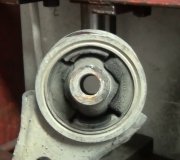The people at any tire and alignment shop should be able to diagnose this. "Suspension" is a system made up of many parts. I do not know which parts you replaced, but suspension and steering parts will not cause a wobble that you feel in the seat or a wobble in the steering wheel. Wobbles are caused by parts that are rotating.
The common causes of a wobble in the steering wheel include a bent wheel, and a broken belt in a tire. The less-common causes include a piece of rust or scale caught between the wheel and the brake rotor or the rotor and the hub. Those problems can be observed by watching the wheels as they spin while running the engine, in gear, on a hoist. It can be verified with a dial indicator to measure the amount of "lateral run out" on the wheel or on the rotor.
The hardest cause of a wobble in the steering wheel to find is a worn inner CV joint housing. This should not be a problem yet on your car at the mileage you listed. The internal rollers run back and forth on very highly-polished grooves as the half shaft rotates, and as its length changes as the suspension moves up and down over bumps in the road. The areas those rollers run in most of the time become worn a very small amount, then, those few times the rollers need to run beyond the worn area, they bind and resist moving that far. Instead of allowing the half shaft to freely change its length, it pushes on the spindle, and therefore on the control arm that is mounted on flexible rubber bushings. The steering linkage is also connected to the spindle, so the moving spindle tugs back and forth on that steering linkage. That is what makes the steering wheel oscillate left and right. The big clue to this is the steering wheel only oscillates when the tires are under load, as in when accelerating, and when the half shaft needs to change length, as in when turning sharply. The oscillating steering wheel commonly occurs when accelerating onto the street from a parking lot, and typically stops once you reach about 35 to 40 mph.
If you replaced suspension system parts that hold the wheel in position, it is required that the car be aligned. If that is not done, the wheel could be tipped in or out on top compared to where it should be. Due to the interaction of the geometry of the numerous parts, a tire that is tipped too far usually also causes it to turn left or right a little. If a wheel is turned far enough, you need to turn the steering wheel the other way to bring both wheels to where they're turned an equal amount. The clue is the steering wheel is not centered when you are driving on a straight road. When the two tires are steering in different directions, the car will follow the one with the most weight on it. The other one will slide down the road, or it will walk off to one side as long as the sidewall can flex, then it will suddenly snap back, then start all over again. That snapping back will be felt in the steering wheel. The clue is you won't feel anything abnormal while driving very slowly. How often the tire snaps back is not related to the number of revolution it makes. That means the oscillation could occur at the same rate at 40 mph and at 60 mph. The rate might change depending on the type of road surface.
In very rare situations a warped brake rotor can be felt as a steering wheel wobble. "Lateral run out" is one way a rotor can be warped. That is usually not felt in the brake pedal, but it can cause the brake caliper to be pushed left and right on its mounting surface once per wheel revolution. The high mass of the caliper makes it resist that movement, so instead, the spindle tends to move left and right. That tugs on the steering linkage and is felt in the steering wheel. This will not be noticed at low speeds, and it may be more noticeable when braking at higher speeds. Lateral run out can be measured with a dial indicator and will show up as excessive only on the rotor, not on the wheel.
If excessive run out is measured on a wheel, and then on the rotor once that wheel is removed, It is almost certain there is something caught between the rotor and hub that is preventing the rotor from sitting squarely on that hub. This occurs quite often when do-it-yourselfers do a brake job. There will be one or three access holes in the hub, and water can spray up there and cause rust spots to build up on the backside of the rotor's mounting surface. Those high spots of rust must be scraped off before the rotor is machined, to prevent machining a warp into it. If the rotor is reinstalled in a different orientation and those rust spots weren't removed, they will hold it away from the hub. Since the wheel bolts to that surface on the rotor, it too will wobble from that lateral run out. If it is bad enough, you will see the steering wobble at very low speeds, such as when driving through a parking lot. It will be felt in the steering wheel at higher speeds.
Sunday, January 8th, 2017 AT 1:57 PM



